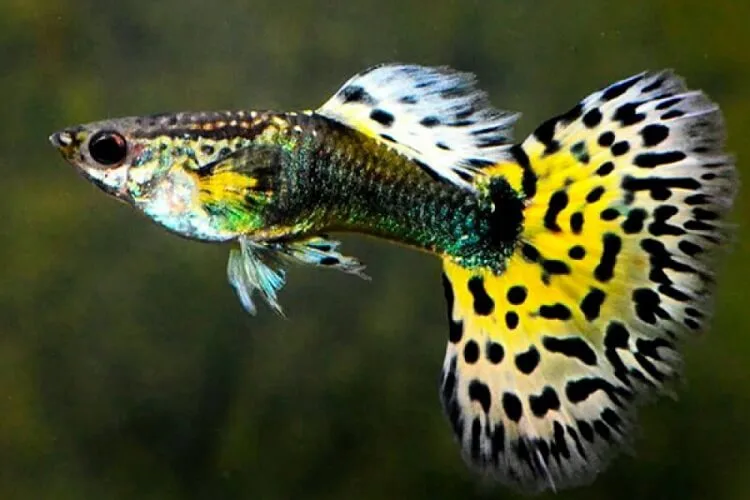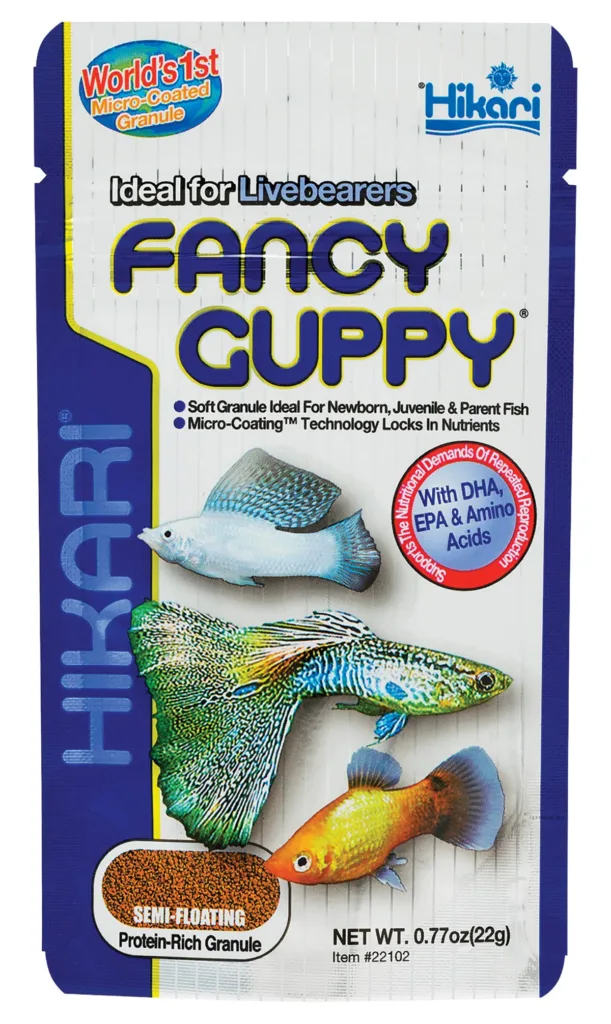A fantail guppy is a type of guppy that has a fan-shaped tail. They are one of the most popular types of guppies for aquariums, due to their colorful and attractive appearance. Fantail guppies come in a wide variety of colors, including red, yellow, blue, green, and black. They can also have different patterns, such as stripes, spots, and marbling. In this guide, we will cover all the essential aspects of caring for Fantail Guppies (Poecilia reticulata), including their appearance, origin, tank setup, breeding, feeding, diseases, and much more.
Fantail guppies are relatively easy to care for, making them a good choice for beginner aquarists. They are also relatively small fish, so they can be kept in a variety of tank sizes. However, it is important to note that fantail guppies are livebearers, meaning that they give birth to live young. This can lead to a rapid increase in the population of your aquarium, so it is important to have a plan for dealing with the fry.
What is a Fantail Guppy?
Fantail guppies are a type of guppy that has a fan-shaped tail. They are one of the most popular types of guppies for aquariums, due to their colorful and attractive appearance. Fantail guppies come in a wide variety of colors, including red, yellow, blue, green, and black. They can also have different patterns, such as stripes, spots, and marbling.
Appearance
- Male: Male fantail guppies are typically smaller and more slender than females. They have long, flowing tails that are often brightly colored. Male fantail guppies also have a gonopodium, which is a modified anal fin that is used for fertilization. Male fantails are typically small only reaching 1.5 to 2.5 inches in length.
- Female: Female fantail guppies are larger and more robust than males. They have shorter, less colorful tails. Female fantail guppies also have a gravid spot, which is a dark spot on their abdomen that darkens as they get closer to giving birth. Female fantails are slightly larger than males generally reaching a size of 2 to 2.5 inches.
Origin

Fantail guppies are a domesticated breed of guppy, which are native to northeast South America. They were first bred in captivity in the early 1900s, and have since become one of the most popular types of guppies for aquariums.
The exact origin of the fantail guppy is unknown, but it is believed to have been developed through selective breeding of wild guppies with particularly large and fan-shaped tails. Fantail guppies were first introduced to the United States in the 1920s, and quickly became popular among hobbyists.
Today, fantail guppies are bred all over the world in a variety of colors and patterns. They are a popular choice for aquariums due to their attractive appearance and relatively easy care requirements.
Tank Setup
Fantail guppies are relatively small fish, so they can be kept in a variety of tank sizes. A minimum tank size of 10 gallons is recommended for a small group of fantail guppies. However, a larger tank is always better, as it will give your fish more space to swim and explore.

Fantail guppies are tropical fish, so they need a tank heater to keep the water temperature between 76 and 82 degrees Fahrenheit. They also need a good filtration system to keep the water clean.
Fantail guppies appreciate having plenty of hiding places in their tank. This can be provided by live plants, driftwood, or rocks. You can also add some artificial decorations to your tank, but make sure they are safe for fish.
Breeding
Fantail guppies are livebearers, meaning that they give birth to live young. The gestation period for fantail guppies is about 21 days.
If you want to breed fantail guppies, you will need to provide them with a separate breeding tank. The breeding tank should be well-planted and have plenty of hiding places for the fry.
How many babies do fantail guppies have?
A female fantail guppy can have between 25 to 60 babies per a time. The size of spawn depends on her diet, breed, and size.
Once the female has given birth, you can move her back to the main tank. The fry can be left in the breeding tank until they are large enough to be moved to the main tank. [How to Breed Guppies: A Comprehensive Step By Step Guide]

Feeding
Fantail guppies are omnivores, meaning that they eat both plants and animals. A good diet for fantail guppies should include a variety of foods, such as flake food, pellets, live brine shrimp, and bloodworms.
You should feed your fantail guppies two to three times per day, only giving them as much food as they can eat in a few minutes. Be careful not to overfeed your fish, as this can lead to health problems.

Diseases
Fantail guppy are relatively hardy fish, but they are still susceptible to some diseases. Some of the most common diseases that affect fantail guppies include:
- Ich: Ich is a parasitic disease that causes white spots to appear on the fish’s body.
- Fin rot: Fin rot is a bacterial infection that causes the fish’s fins to rot away.
- Dropsy: Dropsy is a condition that causes the fish’s abdomen to swell.
If you notice any signs of disease in your fantail guppies, you should isolate them from the other fish and treat them with the appropriate medication.
Expert Advice
Here are some expert tips for caring for fantail guppies:
- Perform regular water changes: It is important to perform regular water changes to keep the water quality in your fantail guppy tank high. Aim to change 25% of the water in your tank once per week.
- Monitor the water parameters: It is important to monitor the water parameters in your fantail guppy tank to ensure that they are within the optimal range. The ideal pH for fantail guppies is between 6.8 and 7.8. The ideal water temperature is between 76 and 82 degrees Fahrenheit.
- Feed your fish a variety of foods: As mentioned previously, fantail guppies are omnivores. To ensure that they are getting all the nutrients they need, it is important to feed them a variety of foods. A good diet for fantail guppies should include flake food, pellets, live brine shrimp, and bloodworms.
- Provide your fish with plenty of hiding places: Fantail guppies are shy fish, so it is important to provide them with plenty of hiding places in their tank. This can be provided by live plants, driftwood, or rocks.
- Be careful not to overfeed your fish: Overfeeding can lead to a variety of health problems in fantail guppies, including obesity, constipation, and swim bladder disease. Feed your fish only as much food as they can eat in a few minutes.
- Isolate sick fish: If you notice any signs of disease in your fantail guppies, it is important to isolate them from the other fish and treat them with the appropriate medication. This will help to prevent the spread of disease to the other fish in your tank.
- Acclimate new fish slowly: When adding new fantail guppies to your tank, it is important to acclimate them slowly to avoid shocking them. To do this, float the bag containing the new fish in your tank for about 30 minutes. Then, add a small amount of tank water to the bag every 10 minutes or so until the bag is full of tank water. Once the bag is full of tank water, you can release the new fish into the tank.
- Quarantine new fish: It is a good idea to quarantine new fish for at least two weeks before adding them to your main tank. This will help to prevent the introduction of any diseases to your main tank.
- Use a quarantine tank: A quarantine tank is a separate tank that is used to isolate and treat sick fish. It is a good idea to have a quarantine tank on hand, even if you do not currently have any sick fish.
- Maintain good hygiene: It is important to maintain good hygiene when caring for your fantail guppies. Wash your hands thoroughly with soap and water before and after handling your fish or tank. Be careful not to cross-contaminate your tanks by using the same equipment in multiple tanks.
Where to buy fantail guppies?
You can buy fantail guppies from a variety of places, including:
- Local fish stores: Local fish stores are a great place to buy fantail guppies, as they can offer you advice on how to care for your fish and help you to choose the right fish for your tank.
- Online retailers: There are a number of online retailers that sell fantail guppies. When buying fantail guppies online, it is important to choose a reputable retailer that has a good track record of customer satisfaction.
- Breeders: Fantail guppy breeders can be a great source of high-quality fish. However, it is important to do your research before buying fantail guppies from a breeder to make sure that they are reputable and that their fish are healthy.
Here are some tips for buying fantail guppies:
- Inspect the fish carefully before you buy them: Look for fish that are active and alert. Avoid fish that are lethargic or have any signs of disease.
- Ask the seller about the fish’s health history: Ask the seller if the fish have been quarantined and if they have been tested for any diseases.
- Ask the seller about the fish’s diet: Ask the seller what the fish have been eating and how often they have been fed. This will help you to transition the fish to their new diet more easily.
Once you have purchased your fantail guppies, it is important to acclimate them slowly to their new tank. To do this, float the bag containing the new fish in your tank for about 30 minutes. Then, add a small amount of tank water to the bag every 10 minutes or so until the bag is full of tank water. Once the bag is full of tank water, you can release the new fish into the tank.
How Much Do Fantail Guppies Cost?
The cost of fantail guppies varies depending on the retailer, the color and pattern of the fish, and the quality of the fish. However, in general, fantail guppies are relatively inexpensive fish. You can expect to pay between $1 and $5 per fish for a good quality fantail guppy. If you are looking for a breeding pair, you may have to pay up $50 per a pair.
When buying fantail guppies, it is important to factor in the cost of other supplies, such as a tank, filter, heater, food, and decorations. You will also need to consider the cost of ongoing maintenance, such as water changes and cleaning the tank.
Overall, fantail guppies are relatively inexpensive fish to care for. They are a good choice for beginner aquarists, as they are relatively easy to care for and they are not very expensive to purchase.










